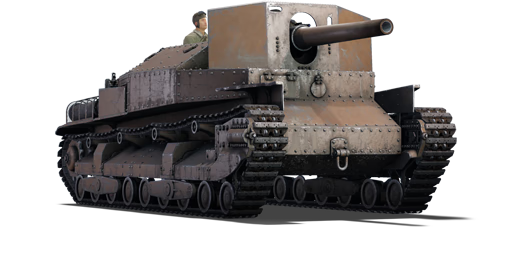

Ground Vehicles
Ro-Go Exp.
I
Rank
AB
1.7
RB
1.7
SB
1.7
Battle rating
Japan
Game nation
Tank destroyer
Main role
4,000

Research
2,100

Purchase
General information
The Ro-Go Experimental was a modification of the Ro-Go platform. It features a French Model 120 mm Schneider-Canet 1898 cannon as its main armament, designed to up-gun unused hulls and press them into service as capable glass-cannon self-propelled guns.
The Ro-Go Exp. was introduced in Update "Ixwa Strike". It possesses a very powerful cannon for the vehicles it faces, but it is based on a slow and sluggish heavy tank hull, which is its main drawback. Additionally, as it is open-topped and relatively thinly armoured, the best course of action is to use this "glass cannon" in a sniping position to engage targets at range.
Camouflages
Survivability and armour
Armour
front / side / back
Hull
25 / 25 / 25 mm
Turret
12 / 0 / 0 mm
Visibility
107 %
Crew
7 persons
Mobility
Max speed
Forward
2325 km/h
Backward
67 km/h
Power-to-weight ratio
11.41019.916.2 hp/t
Engine power
290256507412 hp
Weight
25.5 t
Optics
Gunner
Commander
Driver
Optics zoom
1.9x–3.5x
—
—
Armaments
120 mm Schneider-Canet 1898 cannon
Ammunition
16 rounds
Reload
basic crew → aces
13 → 10 s
Vertical guidance
-10 / 15°
Horizontal guidance
-12 / 12°
Turret Rotation Speed
basic crew → aces
Horizontal
7612.28.8 → 108.517.412.6 °/s
Vertical
4.53.613.98.9 → 6.55.219.812.7 °/s
| Ammunition | Type | Armor penetration (mm) at a distance: | |||||
|---|---|---|---|---|---|---|---|
| 10 m | 100 m | 500 m | 1000 m | 1500 m | 2000 m | ||
| SAPCBC | 63 | 62 | 58 | 53 | 49 | 45 | |
| HE | 25 | 25 | 25 | 25 | 25 | 25 | |
7.7 mm Type 97 machine gun
Ammunition
1,960 rounds
Belt capacity
20 rounds
Reload
basic crew → aces
3.9 → 3 s
Fire rate
498 shots/min
Vertical guidance
-8 / 20°
Horizontal guidance
-110 / 110°
Turret Rotation Speed
basic crew → aces
Horizontal
1411.924.417.6 → 201734.825.2 °/s
Vertical
1411.242.727.3 → 20166139 °/s
| Belt | Belt filling | Armor penetration (mm) at a distance: | |||||
|---|---|---|---|---|---|---|---|
| 10 m | 100 m | 500 m | 1000 m | 1500 m | 2000 m | ||
| AP/AP/T | 13 | 12 | 7 | 3 | 2 | 0 | |
Economy
Repair cost
Basic → Reference
AB
193 → 239 

RB
229 → 283 

SB
271 → 335 

Crew training
600 

Experts
2,100 

Aces
45 

Research Aces
110,000 

Reward multiplier
AB / RB / SB
20 / 20 / 30 % 

100 % 

Total cost of modifications
4,450 

2,680 

Talisman cost
300 

Mobility | |
|---|---|
Protection |
|---|
Firepower |
|---|
Rating by players
You must play more than 3 battles for the last week and more than 10 battles in a vehicle to rate it.
Like:
21
Armor protection:
Not enough ratings
Survivability:
Not enough ratings
Mobility:
Not enough ratings
Armament:
Not enough ratings
Balance:
Not enough ratings
Tips & Tricks
This space is currently empty
Do you know any interesting vehicle features?
Loading...
No articles about this vehicle yet
Become the first author and get rewards!
Write a guide, tell about interesting historical facts, make a tutorial or simply an interesting post.
No more content